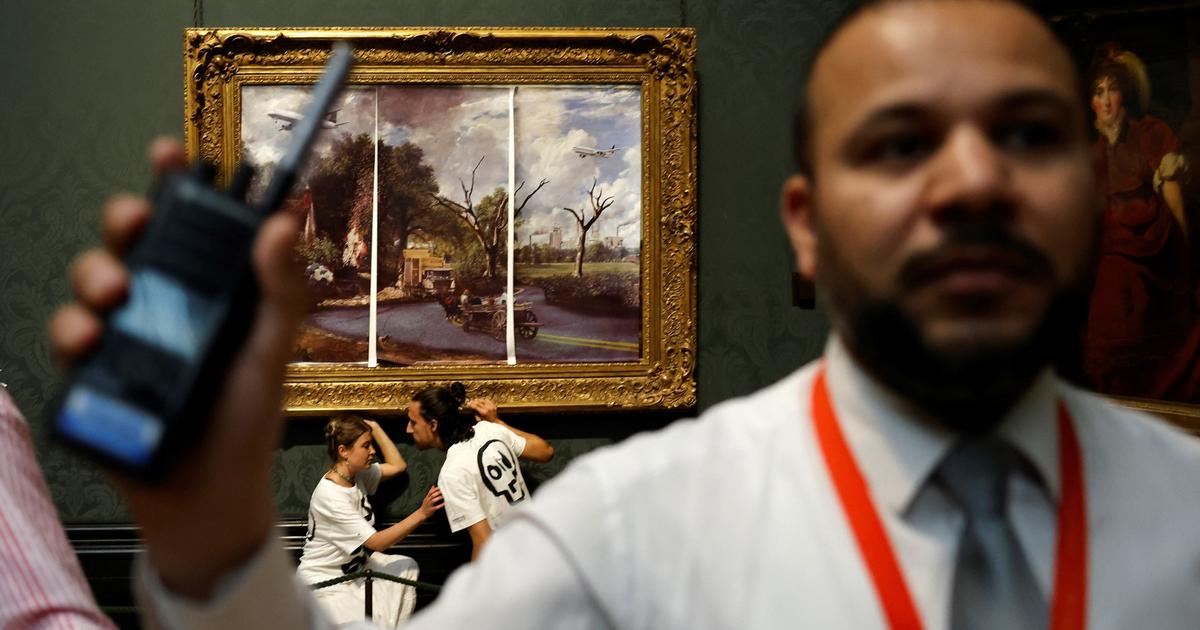Stolen in 1911 from the Louvre by an Italian worker and found two years later, the famous Mona Lisa, considered "
priceless
", was placed under armored glass.
But other masterpieces exhibited in the largest museum in the world do not have such protection: in the event of depredation, destruction or theft, the State is its own insurer and is not compensated.
"
Public authorities do not generally insure their works, with the exception of deposits of private works
", confirms the Ministry of Culture.
In the event of damage in their usual place of exposure, it is “
the State or the community
” which implements “
the necessary expenses
”, explains this same source.
Read alsoEnvironmental activists sharpen their weapons to attack French museums
On the other hand, private institutions such as the Giacometti and Louis Vuitton foundations or the Pinault Collection, "
generally insure their collections
", indicated Irène Barnouin, head in France of the Arts branch of the insurance broker WTW.
It is then the private insurance companies - often "
specialized players from large known insurance groups
", such as Axa XL, Helvetia, Hiscox, Liberty specialties market, QBE - which cover the work, with "
different levels of 'insurance
'.
“Extremely high” cost
For public museums, “
insuring (within their walls) works, often of inestimable value, would not make them less vulnerable and it would be an extremely high expense without correlation with the risk of depredation”, estimates the Ministry of Culture
.
On the other hand, in the event of loan or travel, there is no choice: the works of art must be insured by the institution that borrows them, whether public or private.
It is in the "
handling phases,
when the work is taken down from the nail, wrapped, put it in a means of transport and taken out to put it back on the nail
", that the risk is greatest. high from damaging it, explains Daphne de Marolles, manager in France of the Arts branch of Axa XL.
But the insurance also covers the work once installed in its host organization.
Fortunately for the collector who accidentally broke Saturday at a contemporary art fair in Miami a small glass sculpture by Jeff Koons, estimated at 42,000 dollars.
Read alsoWhat are the risks for activists who attack the masterpieces of European museums?
This “ nail to nail
” guarantee
fixes the value of the work as well as the amount of the insurance premium, which also depends on other parameters (nature of transport, exhibition conditions, etc.).
This premium can amount to "
several million or even hundreds of millions
", according to the Ministry of Culture, which estimates at "
more than one billion euros
" the "
cumulative insurance premiums for loans from national museums granted by the France at the
Louvre Abu Dhabi
(United Arab Emirates) for the exhibition on Impressionism
”, which is held until February.
Asked about their insurance policy, all the museums or foundations contacted declined to comment.
"Symbol"
An action by environmental activists who damage a painting would constitute "
vandalism
", a specific case "
always included in private insurance contracts
", specifies Daphne de Marolles.
But that does not prevent a certain “
worry
” of the institutions, in front of “
aggravated risks
”.
The year 2022 has indeed been marked by numerous punching actions by environmental activists, sprinkling Van Gogh's
Sunflowers
with tomato soup in London or covering
Claude Monet's
Meules with mashed potatoes in Berlin.
Read also“Assuming radicality”: new environmentalist modes of action put to the test of excitement
“
Even if several events have hit the headlines, we are not facing a crazy occurrence
”, tempers Daphne de Marolles.
The works affected so far were "
protected by glass, and the damage relatively low
", underlines the expert.
For her, the attacks of activists are more a "
symbol to send a message
" than a desire to generate "
irreparable damage
".
“
The subject is the safety of works and the safety of establishments
”, estimates the Ministry of Culture, joined on this point by this expert.
However, she believes that art should not be put under glass but rather “
find a certain balance
”, because the mission of a museum is also to “
preserve the emotion of the public in front of a work
”.









